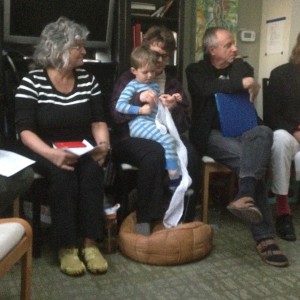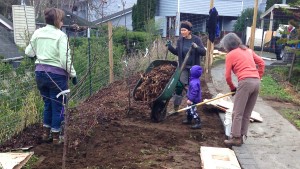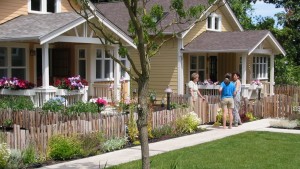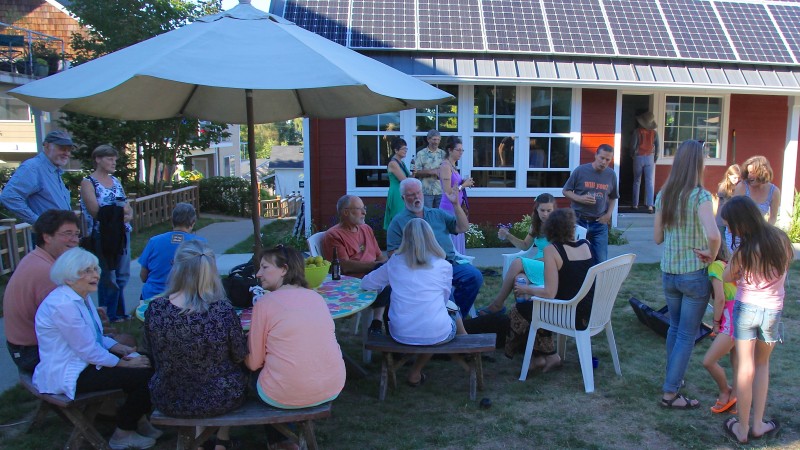I was recently engaged in lively conversation among a group of small-scale developers that started with an online post about an innovative collective housing model in Berlin. The example was seen as an excellent opportunity for community-minded housing for friends, families and seniors. Countering this view was a person who asked why a developer would want to get involved with a messy and needlessly complicated ownership structure. “Live close to family and friends, but don’t include a homeowner’s association with dues and meetings.”
I think these two viewpoints demarcate two camps, though not necessarily mutually exclusive. One is motivated around the benefits of living in an intentional community. The other is focused on building housing that is nested within a larger community and surviving the process to do it again.
When neighbors self-manage a shared commons, some kind of homeowner or neighborhood association is the vehicle to handle agreements and disputes. The aversion to these associations is understandable: they can draw out the worst in human relations. On the other hand, I’ve seen small-scale communities with shared commons providing deeply nourishing and supportive environments in ways that are not common with stand-alone dwellings.
 For example, the other day at the Fifth Street Commons, a single mom told a story of her four-year-old son asking her at bedtime, “Mommy, how many people are in our family?” Her answer, “Johnny, it’s you and me. We’ll always be together.” But he didn’t mean that. “No, Mommy. How many are in our big family?” By which he meant the community of 16 households surrounding the shared commons. His mom works two jobs, and he is welcomed like an extended family member in many of the neighboring households. He’s free to roam beyond his front door to play with friends or practice knitting with the grandmother living in the next building.
For example, the other day at the Fifth Street Commons, a single mom told a story of her four-year-old son asking her at bedtime, “Mommy, how many people are in our family?” Her answer, “Johnny, it’s you and me. We’ll always be together.” But he didn’t mean that. “No, Mommy. How many are in our big family?” By which he meant the community of 16 households surrounding the shared commons. His mom works two jobs, and he is welcomed like an extended family member in many of the neighboring households. He’s free to roam beyond his front door to play with friends or practice knitting with the grandmother living in the next building.
Tagging on to Johnny’s story is another about his neighbor, Dennis, a 60-something year-old man who suffered a nearly fatal bout with pneumonia earlier this spring. He was in the hospital for 10 days, followed by several weeks in recovery at home. All during this time, his neighbors walked his dog, helped with chores, and provided nourishing meals and companionship.
These two examples highlight the soft and social advantages to living in a supportive community. Difficult to measure, but no less real.
 Sweet, but let’s not leave out the messy side of the story. In closely-knit neighborhoods, like all close relationships, there will always be disputes of some kind. Dogs dropping their doo, music playing too loudly, kids leaving bikes out. In a typical condominium, the person feeling offended is likely to call the property manager. In some neighborhoods, residents call the police. With this kind of response, you can be sure that the conflict will escalate, or it will turn inward with unspoken animosity where the offense is left to stew.
Sweet, but let’s not leave out the messy side of the story. In closely-knit neighborhoods, like all close relationships, there will always be disputes of some kind. Dogs dropping their doo, music playing too loudly, kids leaving bikes out. In a typical condominium, the person feeling offended is likely to call the property manager. In some neighborhoods, residents call the police. With this kind of response, you can be sure that the conflict will escalate, or it will turn inward with unspoken animosity where the offense is left to stew.
A neighborhood organization offers a way for neighbors to discuss their shared agreements, responsibilities and goals — before conflicts happen. When disputes do come up, they have methods for resolving the issues with respect and civility – whether minor quarrels or major riffs, often bringing the community closer together, or at least leaving the parties with a mutual understanding of differing viewpoints.
 Homeowner’s associations aside, when neighbors have opportunities to work together, conflicts are less likely to escalate. For example, when you and your neighbors take part in preparing the community garden or mending a fence, you’ll chat about your kids, tell stories, discuss the upcoming election. Later, when the neighbor’s late evening party is getting loud, you will have a ground of relationship on which to approach them without an overblown reaction.
Homeowner’s associations aside, when neighbors have opportunities to work together, conflicts are less likely to escalate. For example, when you and your neighbors take part in preparing the community garden or mending a fence, you’ll chat about your kids, tell stories, discuss the upcoming election. Later, when the neighbor’s late evening party is getting loud, you will have a ground of relationship on which to approach them without an overblown reaction.
There is no doubt: adding a community organization element into a developer’s mix is extra work and potentially sticky. Developers don’t have to be community organizers or have a degree in social science, but if they want help their buyers or renters get off to a healthy start, they should be aware of the tools they can offer them work with. We gathered a few community process resources listed community process resources as a start. Our Cohousing cousins have done deep work with group process and are generous with sharing their tools and experiences. These will help in establishing frameworks for group decision-making processes, dispute resolution, and vibrant living.
 Even before renting or buying a home within a pocket neighborhood or intentional community, it is important to realize you will be living among neighbors who want to be neighborly. There are other places to keep completely to one’s self; this is not one of them. That doesn’t mean giving up privacy, but living in a community implies a degree of sharing and caring. This is especially true if real estate brokers are involved. They are not just selling a house (or apartment); they are selling a neighborhood. With that come the expectations, responsibilities and rewards of living in a community.
Even before renting or buying a home within a pocket neighborhood or intentional community, it is important to realize you will be living among neighbors who want to be neighborly. There are other places to keep completely to one’s self; this is not one of them. That doesn’t mean giving up privacy, but living in a community implies a degree of sharing and caring. This is especially true if real estate brokers are involved. They are not just selling a house (or apartment); they are selling a neighborhood. With that come the expectations, responsibilities and rewards of living in a community.
For sure, closely-knit neighborhoods are not for everyone. But those who choose them will benefit from their supportive shared framework and self-management tools.
—Ross Chapin


